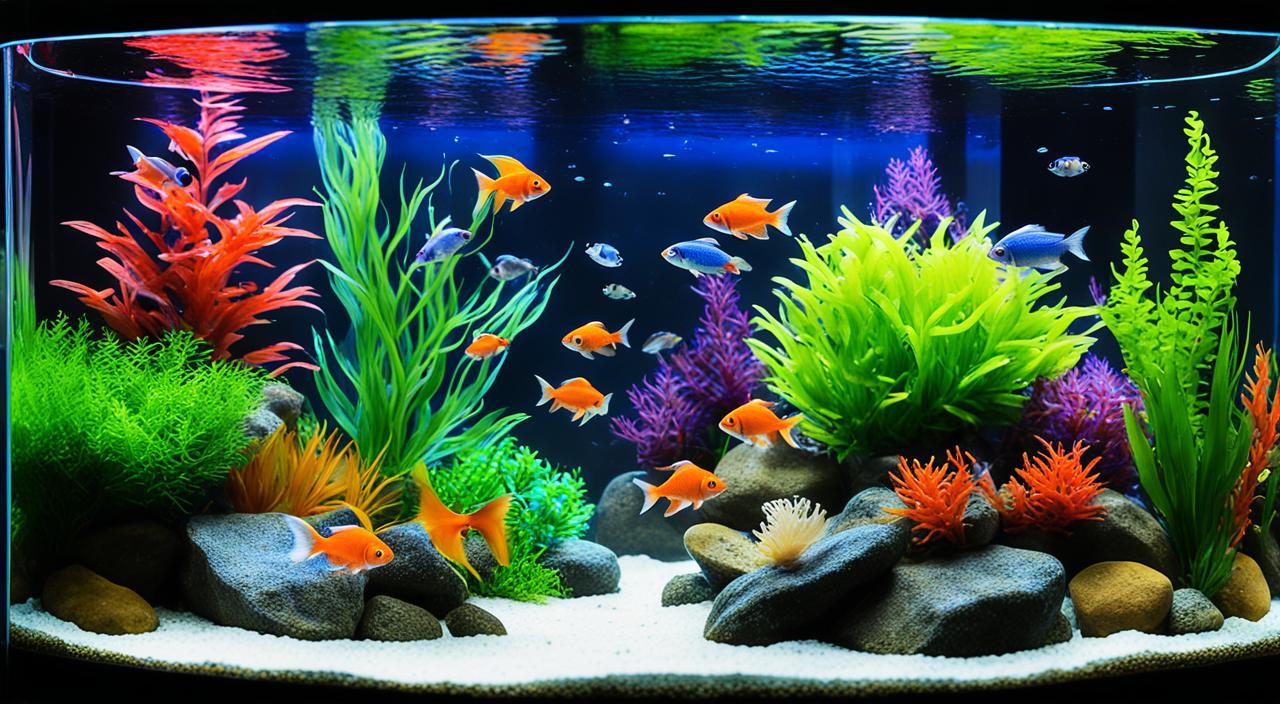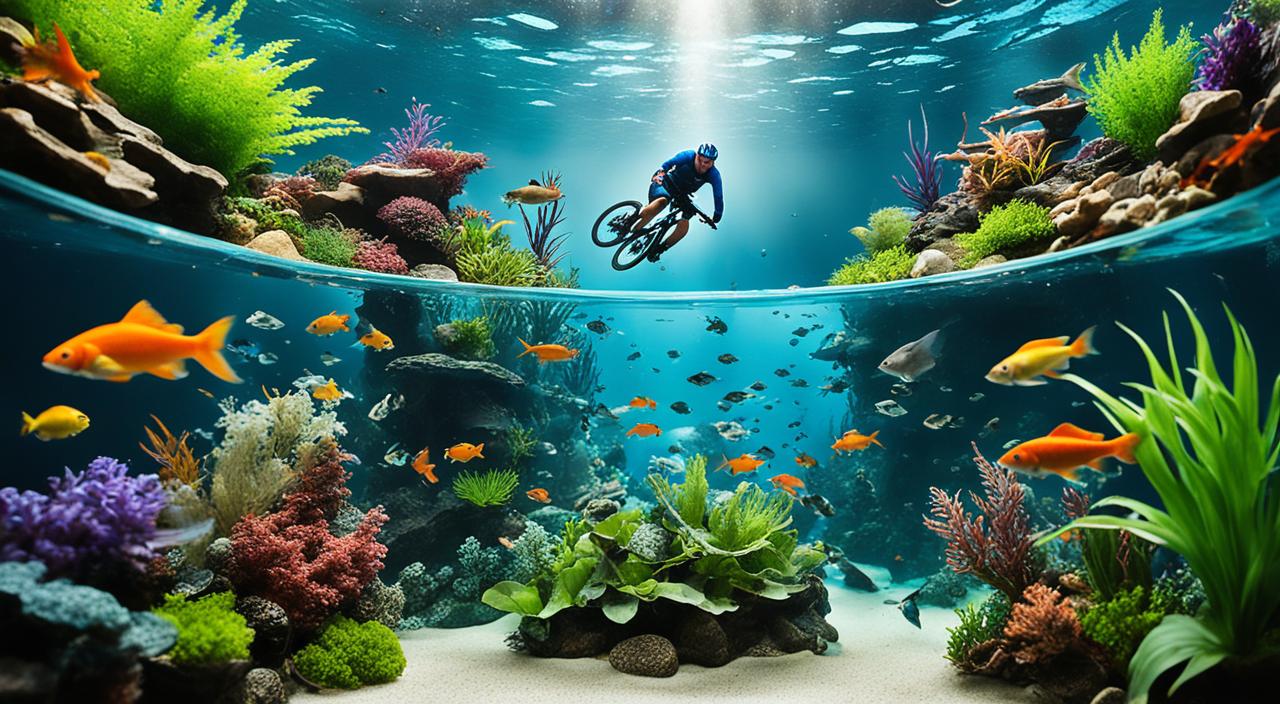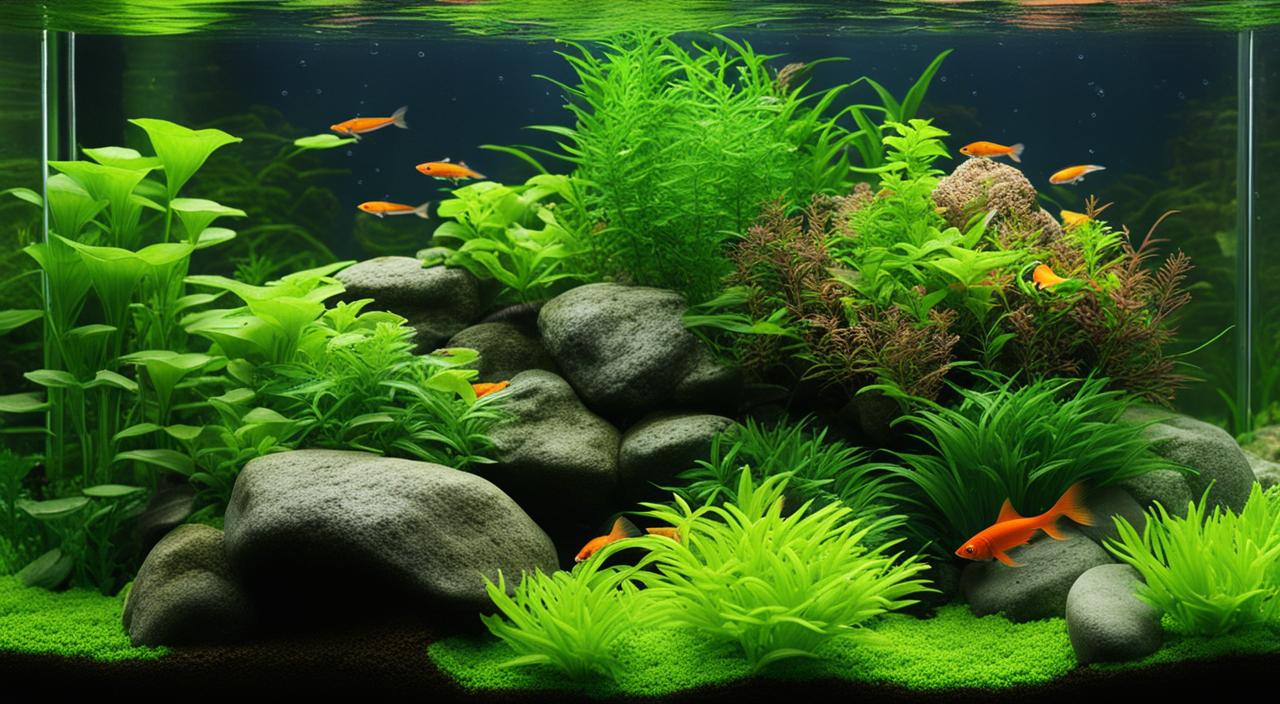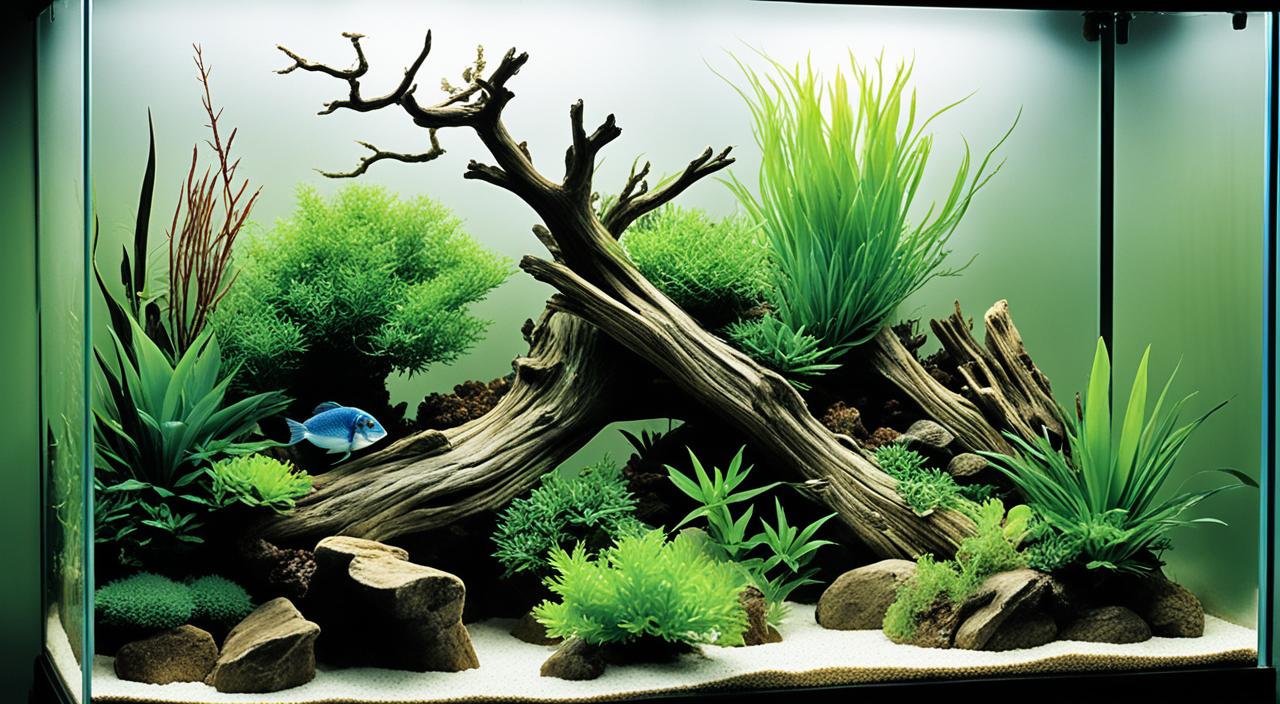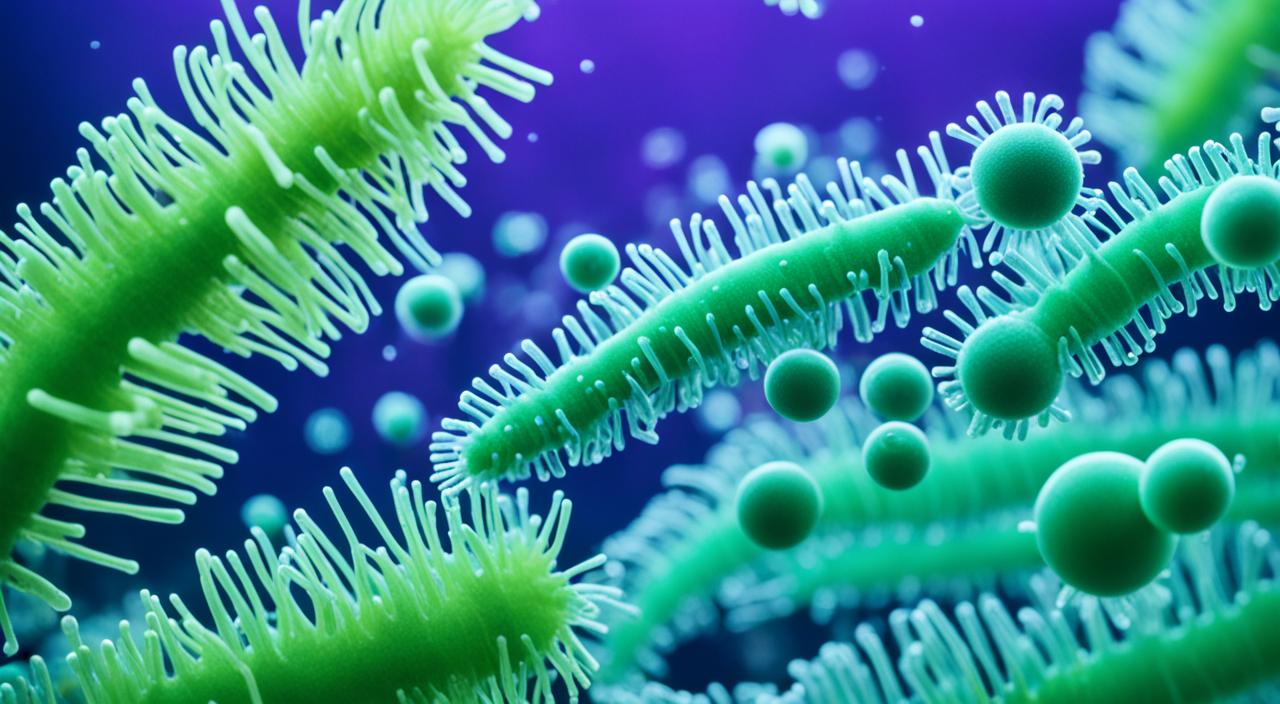Building a healthy environment for your aquarium doesn’t have to involve the risks associated with cycling a fish tank using live fish. You can establish a thriving aquarium without subjecting fish to potential harm with fishless cycling methods. You can create a sustainable and balanced aquatic ecosystem by understanding the nitrogen cycle and harnessing the power of beneficial bacteria.
The nitrogen cycle is a natural process in both nature and aquariums. It involves the conversion of harmful ammonia, produced by fish waste and uneaten food, into less toxic compounds like nitrite and, eventually, nitrate. Beneficial bacteria play a crucial role in breaking down ammonia, so it’s essential to cultivate their growth during the cycling process.
There are various fishless cycling methods to choose from. One approach is introducing an ammonia source, such as pure ammonia, to provide food for the beneficial bacteria. Another technique involves using seed material, like filter media or gravel from an established aquarium, to introduce the bacteria into the new tank. Regular monitoring of ammonia, nitrite, and nitrate levels allows you to track the progress and make any necessary adjustments throughout the cycling process.
While fishless cycling is the preferred method, there are alternative approaches that some aquarists may opt for. Fish-in cycling involves adding live fish to the tank, allowing their waste to be the ammonia source. However, this method can be stressful and potentially harmful to the fish. Another alternative is using products that claim to cycle the aquarium. Choosing a reliable product that introduces the appropriate strains of beneficial bacteria is crucial.
To complete a fishless cycle, follow a series of steps, including setting up the aquarium, dechlorinating tap water, adding an ammonia source, and regularly testing ammonia and nitrite levels. Water changes may be necessary to maintain the appropriate ammonia and nitrite levels throughout the process. The cycle is complete when both ammonia and nitrite levels are reduced to zero.
By following these steps and implementing some helpful tips, such as using pure ammonia without additives, dosing accurately with pipettes, and adding seed material from established tanks, you can ensure a successful fishless cycling process. Remember, regular water changes can help manage high nitrite levels and provide a healthy environment for beneficial bacteria to thrive.
Key Takeaways:
- Fishless cycling methods allow for the establishment of a healthy aquarium without the use of live fish.
- The nitrogen cycle is a natural process that converts ammonia into less toxic compounds through the action of beneficial bacteria.
- Methods include introducing ammonia or using seed material from established tanks to cultivate beneficial bacteria growth.
- Alternatives to fishless cycling include fish-in cycling, which can harm the fish and products that claim to cycle the aquarium.
- Completing a fishless cycle includes setting up the aquarium, dechlorinating tap water, adding an ammonia source, and monitoring ammonia and nitrite levels.
The Nitrogen Cycle in Aquaria
The nitrogen cycle is a fundamental biological process in natural environments and aquariums. Understanding this cycle is crucial for maintaining a healthy and balanced aquarium ecosystem.
Fish waste, uneaten food, and decaying plant matter produce ammonia in an aquarium. Ammonia is highly toxic to fish and can cause serious health issues if not properly managed. However, beneficial bacteria known as Nitrosomonas convert ammonia into nitrite in a well-established aquarium.
Nitrite is also toxic to fish, but another group of beneficial bacteria called Nitrobacter convert nitrite into nitrate. Nitrate, in low concentrations, is relatively harmless to fish and serves as a nutrient for aquarium plants. However, high levels of nitrate can lead to algae blooms and other water quality issues.
The nitrogen cycle relies on the presence of beneficial bacteria to break down ammonia and nitrite into less harmful compounds. These bacteria are essential for maintaining a stable and healthy aquarium environment.
Here is a table summarizing the different stages of the nitrogen cycle:
| Stage | Key Players | Compound | Effects on Fish |
|---|---|---|---|
| Ammonia | N/A | Highly toxic | This can lead to algae blooms and other water quality issues in high concentrations. |
| Nitrite | Nitrosomonas bacteria | Toxic | Can cause fish stress and illness |
| Nitrate | Nitrobacter bacteria | Relatively harmless in low concentrations | Can lead to algae blooms and other water quality issues in high concentrations |
Aquarists can create a healthy and thriving aquarium environment by understanding the nitrogen cycle and the role of beneficial bacteria.
Fishless Cycling Methods
When it comes to establishing the nitrogen cycle in aquariums, aquarists can employ several fishless cycling methods. These methods provide a safe and effective way to introduce and cultivate beneficial bacteria in the tank, ensuring a healthy and stable environment for future fish inhabitants.
One popular fishless cycling method involves using a pure ammonia source to provide the necessary ammonia for the beneficial bacteria to feed on. By dosing the aquarium with the appropriate amount of pure ammonia, aquarists can simulate the presence of fish waste and kick-start the cycling process. Regularly testing the ammonia levels during this process is crucial to monitor the progress and make necessary adjustments.
Another effective method is introducing seed material from an established aquarium into the new tank. This can include filter media, gravel, or other items that contain beneficial bacteria. Aquarists can rapidly introduce the beneficial bacteria needed to establish the nitrogen cycle by adding these materials to the aquarium. This method can help expedite cycling and ensure a stable and healthy environment for future fish.
To assist you in understanding the different fishless cycling methods, here is a handy table summarizing the key aspects of each method:
| Fishless Cycling Method | Description |
|---|---|
| Pure Ammonia Dosing | Dosing the aquarium with pure ammonia to provide an ammonia source for the beneficial bacteria. |
| Seed Material Introduction | Introducing seed material, such as filter media or gravel, from an established aquarium to introduce beneficial bacteria. |
Both of these methods effectively establish the nitrogen cycle in your aquarium. However, it’s important to note that fishless cycling requires regular monitoring of ammonia, nitrite, and nitrate levels throughout the cycling process. Testing kits can measure these levels and ensure that the aquarium is progressing towards a stable and healthy environment for fish.
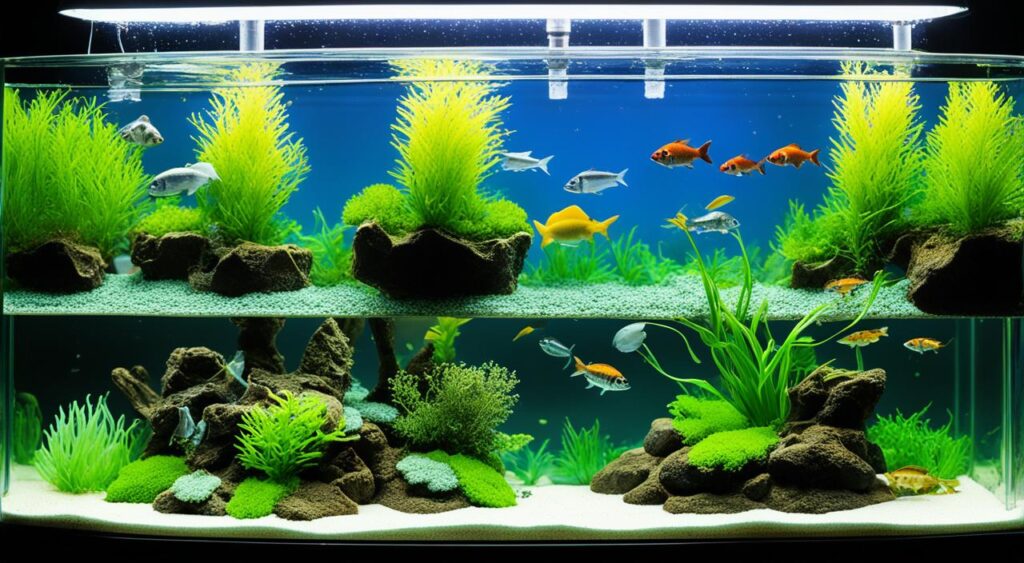
By employing these fishless cycling methods and closely monitoring water parameters, aquarists can successfully establish a thriving nitrogen cycle in their aquariums. This lays the foundation for a healthy and sustainable aquatic ecosystem supporting and nurturing their future fish companions.
Alternative Cycling Methods
While fishless cycling is the preferred method for establishing the nitrogen cycle, there are alternative approaches that some aquarists may consider. Here, I will discuss two methods – fish-in cycling and product cycling.
Fish-in Cycling
In fish-in cycling, fish are introduced into the aquarium right from the start, and their waste serves as the primary source of ammonia for the beneficial bacteria to establish the nitrogen cycle. While this method may seem convenient, it can be stressful and potentially harmful to the fish. The ammonia levels can spike, exposing the fish to toxic conditions. It is crucial to closely monitor the ammonia and nitrite levels and perform frequent water changes to keep them in check. Additionally, adding a beneficial bacteria supplement can help accelerate the establishment of the nitrogen cycle, providing a more favourable environment for the fish.
Product Cycling
Another method some aquarists may opt for is product cycling. This involves using commercial products that claim to introduce beneficial bacteria into the aquarium, jumpstarting the nitrogen cycle. However, it’s important to note that not all products are created equal. The effectiveness of these products may vary, and it’s crucial to choose a product that contains appropriate bacteria strains capable of establishing a stable and healthy nitrogen cycle. It’s always recommended to research and consult with knowledgeable aquarium experts before relying solely on such products.
While fish-in cycling and product cycling are alternative methods that can be used to establish the nitrogen cycle, it’s essential to remember that fishless cycling remains the most recommended and reliable approach. By utilizing fishless cycling, aquarists can create a safe and stable environment for their fish, allowing the nitrogen cycle to develop naturally and ensuring their aquatic companions’ long-term health and well-being.
| Method | Advantages | Disadvantages |
|---|---|---|
| Fish-in Cycling | – Convenient | – Stressful and potentially harmful to the fish |
| Product Cycling | – Quick establishment of the nitrogen cycle | – Effectiveness of products may vary |
Steps to Completing a Fishless Cycle
Aquarists must follow a series of steps to complete a fishless cycle successfully. First, the aquarium needs to be fully set up with functioning equipment. Dechlorinating tap water is crucial to prevent the harmful effects of chlorine on beneficial bacteria. Next, an ammonia source, such as pure ammonia, should be added to the aquarium to feed the beneficial bacteria. Regular testing of ammonia and nitrite levels is necessary to track the cycle’s progress. Water changes may be required to maintain appropriate levels of ammonia and nitrite. The cycle is complete when both ammonia and nitrite are reduced to zero.
Step 1: Set up the Aquarium with Functioning Equipment
Before starting the fishless cycle, ensure that the aquarium is fully set up and equipped with everything it needs. This includes a suitable filter, heater, and lighting. Additionally, ensure the aquarium is cleaned correctly and free from contaminants that could interfere with the cycling process.
Step 2: Dechlorinate Tap Water
Dechlorinating tap water is crucial to protect the beneficial bacteria from the harmful effects of chlorine. Use a dechlorinated product or let the water sit for at least 24 hours to allow the chlorine to dissipate naturally.
Step 3: Add an Ammonia Source
Add an ammonia source to the aquarium to provide food for the beneficial bacteria. Pure ammonia can be obtained from pet stores or online retailers, ensuring it does not contain additives. Use a dosing pipette or calculator to add the amount of ammonia to the tank based on its volume.
Step 4: Regularly Test Ammonia and Nitrite Levels
Regularly test the aquarium’s ammonia and nitrite levels to monitor the fishless cycle’s progress. Use liquid test kits for accurate results. Initially, ammonia levels will rise and gradually decline as the beneficial bacteria establish and convert it into nitrite. Nitrite levels will then increase and eventually decrease as nitrate-producing bacteria take over.
Step 5: Maintain Appropriate Levels through Water Changes
During the fishless cycle, it may be necessary to perform water changes to maintain appropriate ammonia and nitrite levels. If either of these levels becomes too high, perform a partial water change to dilute the concentration. Be sure to use dechlorinated water when performing water changes.
Step 6: Completion of the Fishless Cycle
The fishless cycle is considered complete when both ammonia and nitrite levels have been reduced to zero. At this point, nitrate will be present in the aquarium, which indicates a well-established nitrogen cycle. Nitrate can be managed through regular water changes to keep levels within a safe range for the aquarium inhabitants.
| Step | Description |
|---|---|
| Step 1 | Set up the Aquarium with Functioning Equipment |
| Step 2 | Dechlorinate Tap Water |
| Step 3 | Add an Ammonia Source |
| Step 4 | Regularly Test Ammonia and Nitrite Levels |
| Step 5 | Maintain Appropriate Levels through Water Changes |
| Step 6 | Completion of the Fishless Cycle |
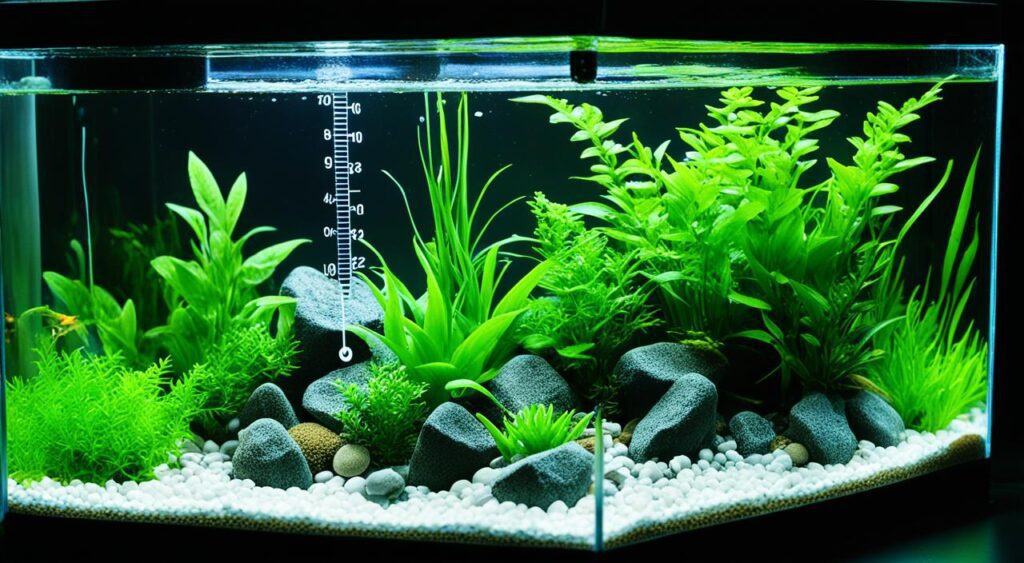
Tips for a Successful Fishless Cycle
There are a few tips to keep in mind to ensure a successful fishless cycle. First and foremost, it is essential to use pure ammonia without any additives that could potentially harm the inhabitants of your aquarium. Using dosing pipettes can be incredibly helpful for accurately measuring and adding the right amount of ammonia to your tank.
Another tip is to consider adding seed material from an already-established aquarium. This can help speed up the colonization of beneficial bacteria in your new tank, jumpstarting the cycling process. Introducing these bacteria creates a favourable environment for the ammonia to be converted into nitrite and, eventually, nitrate.
Remember to regularly dose ammonia to maintain the proper levels required for the bacteria to thrive in the tank. Monitor the ammonia and nitrite levels closely throughout the process to ensure they are within the desired range. High nitrate levels can be harmful, so regular water changes can help manage and control these levels, maintaining a healthy environment for the beneficial bacteria to grow.
FAQ
What is fishless cycling?
Fishless cycling is a method used to establish a healthy aquarium environment without the need for fish. It involves recreating the natural nitrogen cycle in the aquarium, which is responsible for breaking down toxic ammonia into nitrite and then into nitrate. This process is facilitated by beneficial bacteria that feed on ammonia and convert it into less harmful compounds.
What is the nitrogen cycle?
The nitrogen cycle is a vital biological process that occurs in both nature and aquariums. In the aquarium, fish waste and leftover food produce ammonia, which is toxic to fish. Nitrosomonas bacteria convert ammonia into nitrite, another toxic compound. Then, nitrobacter bacteria convert nitrite into nitrate, a less harmful compound. Keeping nitrate levels low is essential for maintaining a healthy aquarium. This cycle relies on the presence of beneficial bacteria to break down these compounds.
What are fishless cycling methods?
There are several fishless cycling methods that aquarists can use to establish the nitrogen cycle in their aquariums. One common method is to dose the aquarium with pure ammonia, which serves as an ammonia source for the beneficial bacteria. Another method is to use seed material, such as filter media or gravel from an established aquarium, to introduce the beneficial bacteria into the new tank. It is also important to regularly test the ammonia, nitrite, and nitrate levels during the cycling process to monitor the progress and make any necessary adjustments.
Are there alternative cycling methods?
Yes, there are alternative methods that some aquarists may choose to use. Fish-in cycling involves adding fish to the aquarium and allowing their waste to provide the ammonia source for the beneficial bacteria. However, this method can be stressful and potentially harmful to the fish. Another option is using products that claim to cycle the aquarium. These products introduce beneficial bacteria into the tank, but their effectiveness may vary, and it is essential to choose a product that actually adds the appropriate bacteria strains.
What are the steps to completing a fishless cycle?
To complete a fishless cycle successfully, aquarists must follow a series of steps. First, the aquarium needs to be fully set up with functioning equipment. Dechlorinating the tap water is crucial to prevent the harmful effects of chlorine on the beneficial bacteria. Next, an ammonia source, such as pure ammonia, should be added to the aquarium to feed the beneficial bacteria. Regular testing of ammonia and nitrite levels is necessary to track the progress of the cycle. Water changes may be required to maintain appropriate levels of ammonia and nitrite. The cycle is considered complete when both ammonia and nitrite are reduced to zero.
What are some tips for a successful fishless cycle?
In addition to following the basic steps of a fishless cycle, there are some tips that can help ensure a successful cycling process. It is crucial to use pure ammonia without any additives that may harm the aquarium inhabitants. Dosing pipettes can be useful for accurately measuring and adding ammonia to the tank. Adding seed material from an established aquarium can speed up the colonization of beneficial bacteria in the new tank. It is also important to dose ammonia as needed to maintain the levels required for the bacteria to thrive. Regular water changes can help manage high levels of nitrite and maintain a healthy environment for the beneficial bacteria to grow.

